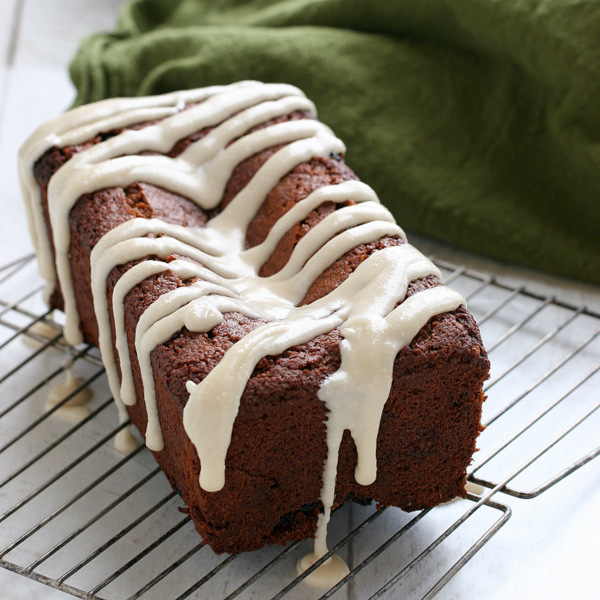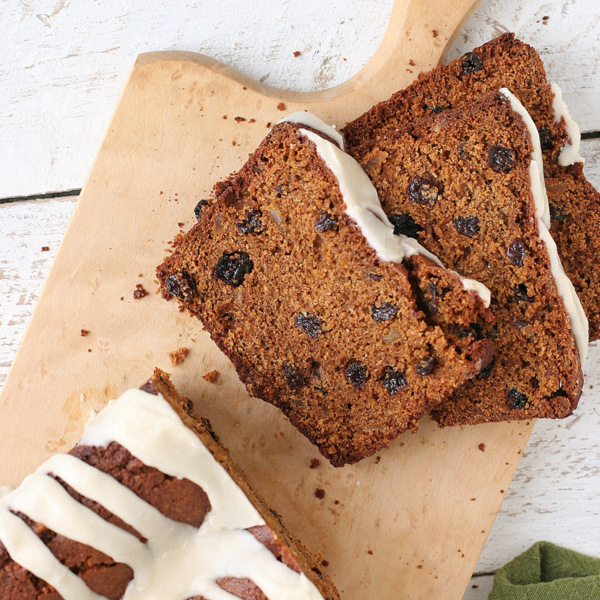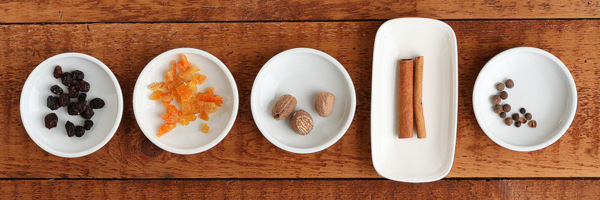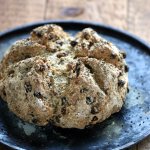A Mutt and Her Almost Irish Spice Bread
Arán Spíosraí is Irish for spice bread, er, or maybe it’s spiced bread. Spices bread?
Let’s get this out of the way though it’s likely obvious by now: I’m not Irish. This translation was sprinkled over the internet and verified by Google’s imperfect translator. I’ve never been to Ireland. And to my knowledge I’ve never tasted Irish spice bread. Further complicating my kitchen tribute to St. Patrick is that none of my second generation Irish friends had ever heard of arán spíosraí. For the record, they don’t speak Irish either.
Craving something sweeter than soda bread and perhaps convinced I could reap the luck of the Irish through baking, I persevered. I’d found the original recipe at Irishabroad.com. A subsequent search for variations proved fruitless. Countless aggregate recipe sites, Irish or otherwise, listed recipes for arán spíosraí, but with minor exceptions, they were all the same. What if arán spíosraí is a mythical creation like the Leprechaun?
To meet my “must be sweet” and “must be Irish” criteria, I considered a tried and true sticky toffee pudding, but I’d already been seduced by the notion of my arán spíosraí’s spicy sweetness perfuming the house. (In the interest of full disclosure, my friend Melanie makes an other-worldly sticky toffee pudding that I will likely never be able to replicate.) Besides, this was an opportunity to try something new and gain insight into a country and culture I’d admired only from afar.
I’m drawn to foods steeped in history, foods that speak of a specific time and place even if I’ve never experienced that place first hand. Perhaps my own lack of family history is the reason for this. I’m what genealogists, or maybe just my husband, call a mutt. I don’t know when my ancestors arrived in the U.S., or how they got here. I don’t who was on which boat across the Atlantic or who checked in and misspelled our name on Ellis Island. My surname is supposedly German though I’m not certain my dad even knew that. (Yes, I gleaned that nugget from the internet too.) As the story goes, my great grandmother on my mom’s side was a Blackfoot Indian, which of course rules out the boat in one instance. I lost access to my family history when my parents died. By the time I was curious enough to ask the important questions, they were gone.
Being a “mutt” has never bothered me except in the matters of food. As a child I watched my friend Karen’s mom roll out tortillas by hand, something she had learned to do from her mother when she was a young girl. She laid them directly on the gas burner of her stove where they would puff slightly over the bright blue flame. After a few seconds she’d grab the hot tortilla between her calloused thumb and forefinger and quickly flip it on the makeshift cook-top. When it was ready she plucked it from the stove and dropped it on a plate. A little butter. A quick sprinkle of cinnamon and sugar. I was glued to her side the whole time. (The magic was lost on Karen. She envied my mom’s Kraft Mac and Cheese casseroles.)
For years I longed for that kind of history, to have learned the art of strudel dough at the knee of a German grandmother. But more recently as I reflect on fifteen years worth of recipes that fill my five recipe journals, I can appreciate that being without a history that I was obligated to repeat has freed me to explore other cultures and traditions. I’m not locked into the cold, Polish breakfast foods that my in-laws serve every year for Easter though I deeply respect the tradition, their tradition. I stuff my pierogis with farmers cheese. And I also stuff them with roasted butternut squash and caramelized onions. I’m equally satisfied putting together a mezze platter loaded with muhammara, hummus, and warm pita as I am a cheese board. My Indian curries find their way into my all-American cheesecakes. Swedish Limpa bread makes its way into our bread rotation on a regular basis. And I’m adding saltandserenity‘s lovely Jewish hamentashen to my Christmas cookie list for 2012.
Munching on my sweet and oh, so satisfying Irish spice bread, I’m already thinking about Easter. Last year I made my first-ever Kulich, a Russian yeast bread. This year, I’m torn between a Polish babka or an Irish Simnel cake. Or maybe I’ll make them both.
Almost Irish Spice Bread
-
The pronounced sweetness in this “bread” pushes it closer to the cake category though with half the fat of most cakes. None of the recipes I found suggested a frosting, but the dry crumb of this intensely flavored bread-cake called for a little something creamy. If you’re not a fan of whiskey, substitute orange juice and double the amount of vanilla extract. Or skip the frosting and slather it with some Kerrygold butter instead. Éirinn go brách!
Ingredients
BREAD:
-
2 cups white whole wheat flour (or all-purpose)
2 teaspoons baking powder
1/2 teaspoon baking soda
1/4 teaspoon cinnamon
1/4 teaspoon freshly ground nutmeg
1/4 teaspoon ground allspice
1/2 teaspoon ground ginger
1/2 teaspoon salt
1 cup raisins
1/4 cup candied citron, chopped
1/2 cup unsalted butter
3/4 cup brown sugar
1/3 cup honey*
1/3 cup molasses*
1 large egg
1/4 cup milk
GLAZE (optional):
-
1 tablespoon unsalted butter
1 cup powdered sugar
1/2 teaspoon vanilla
3 tablespoons Irish whiskey (or orange juice)
pinch of sea salt
Preparation
- Preheat the oven to 325°F.
- Line a 9×5-inch loaf pan with parchment paper or grease it with butter. (I sometimes like making two smaller loaves–one to enjoy now and a second to stow in the freezer for unexpected guests. The smaller loaves also seem to bake more evenly.)
- In a large mixing bowl, whisk together the dry ingredients. Stir in the raisins and candied citron. Make a well in the center.
- In a small sauce pan, melt the butter. Remove it from the heat and stir in the brown sugar and your liquid sweetener(s) of choice. Beat in the egg and milk.
- Add the wet ingredients to the dry and stir until just combined. Scrape the batter into the prepared pan(s).
- Bake for 50-60 minutes, until a toothpick inserted into the center comes out clean. (Adjust the baking time if you are using smaller loaf pans.)
- Cool on a rack for 20 minutes then remove from the pan. Allow to cool completely before glazing.
- To make the glaze, melt the butter in a small saucepan. Remove from heat and whisk in powdered sugar, vanilla, and whiskey or orange juice. Allow the glaze to cool and thicken for 15 minutes. Spoon the glaze into a pastry bag fitted with a large tip or into a sturdy plastic bag with a 1/2-inch opening in the corner. Pipe glaze in a zigzag pattern across the top of the bread.
* The original recipe calls for golden syrup, a product made in the process of refining sugar cane juice into sugar. With no golden syrup in the pantry, I substituted equal parts honey and molasses. You can also substitute light or dark corn syrup.














I’ll bet the kitchen smelled yummy!
To be honest, Irish is all but a dead language these days – I think a few people in select communities speak it, particularly the older generations. But, I don’t think I’ve ever met an Irish person who can speak Gallic… Anyway, this bread looks truly incredibly – sounds truly amazing :D. The photography is excellent as usual.
The translation is correct, but I doubt a Gaelgoir (person who speaks Irish as their first language) would refer to it as that. As for frugalfeeding, above, the language is called “Gaeilge”, not “Gallic”, a common and irritating misconception. A lot of Irish people have the ability to speak the language, and it’s taught at University level countrywide. In fact, it’s still necessary to hold a degree in it in order to become a primary school teacher.
Just a little culture lesson for you there. Happy St. Patrick’s Day. 🙂
I laughed throughout this post. You’re funny Bobbi. God bless you for this wonderful attempt attempt. I think it is beautiful and I bet really delicious. And as for making babka or a Simnel cake for Easter, I say make them both!!!!
I love the place where cakes and bread come together as one. This looks wonderful.
I’m so pin-interesting this recipe! Saw it a while ago, and forgot to do so – have been looking all over wordpress ever since! @frugalfeeding, I’m not Irish, and only met a few, but most of the few spoke their native language! You were hanging out with the wrong Irish!!!